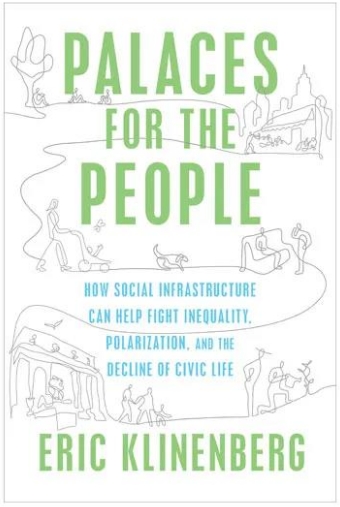


Book title: Palaces for the People: How Social Infrastructure Can Help Fight Inequality, Polarization, and the Decline of Civic Life
Author: Eric Klinenberg
Year: 2018年
Publisher: Crown Publisher
ISBN: 9781524761165 (288 pages, in English)
Eric Klinenberg is a sociology professor at New York University. In his latest book, Palaces for the People: How Social Infrastructure Can Help Fight Inequality, Polarization, and the Decline of Civic Life, Professor Klinenberg introduces the concept of social infrastructure and asserts that social infrastructure is crucial to the maintenance of social connection and collective life. Klinenberg believes that the health of a democratic society depends not just on common values but also on shared social infrastructure. The academic merit of this book lies in its introduction and elaboration of the concept of “social infrastructure,” offering a social value perspective to explain the importance of social infrastructure, such as libraries, parks, and cafes, in social connection and collective life.
This book uses an abundance of social research evidence and case studies to demonstrate that social infrastructure plays a key role in building a good city. It is structured into eight parts, of which the first and the eighth are introduction and conclusion respectively, and the other parts are the six core chapters.
The book begins with the concept of social infrastructure, pointing out that social infrastructure is a term to describe the foundational elements underpinning social life and that social infrastructure and physical infrastructure together constitute the lifeline system of a city. From Chapter 1 to Chapter 6, the author employs many social cases to illuminate the pivotal networking role of social infrastructure, including mitigating social isolation in American cities, social effects of different types of social infrastructure, its influence in people’s health, its strong resilience in times of crisis, etc. In the conclusion part of this book, the author points out the dilemma that social infrastructure faces at present, in which the importance of social infrastructure is yet to be comprehensively acknowledged.
In the realm of architecture and urban and rural planning, space, as the core research object, is the physical carrier of politics, economy, and society. The concept of social infrastructure proposed in this book underscores the social value of space production from the multi-dimensional social effects, thereby complementing the limited understanding of public space production in the traditional view of space.
In China, the study of social infrastructure, by interpreting the relationship between space systems and social interaction, can facilitate the efficient integration of social infrastructure resources and actualize the value of space production, thereby offering a constructive path to building harmonious, liveable, resilient, and inclusive cities.
Reviewers:
Meng Qinghe, PhD Candidate, School of Architecture and Design, Harbin Institute of Technology; Key Laboratory of Cold Region Urban and Rural Human Settlement Environment Science and Technology, Ministry of Industry and Information Technology, Harbin, P. R. China.
Lu Ming, PhD, Professor, School of Architecture and Design, Harbin Institute of Technology; Key Laboratory of Cold Region Urban and Rural Human Settlement Environment Science and Technology, Ministry of Industry and Information Technology, Harbin, P. R. China.
Source: <https://mp.weixin.qq.com/s/Ho-OgXH1HWY2NOp-IJatfw>
Edited by Liang Xiuchun